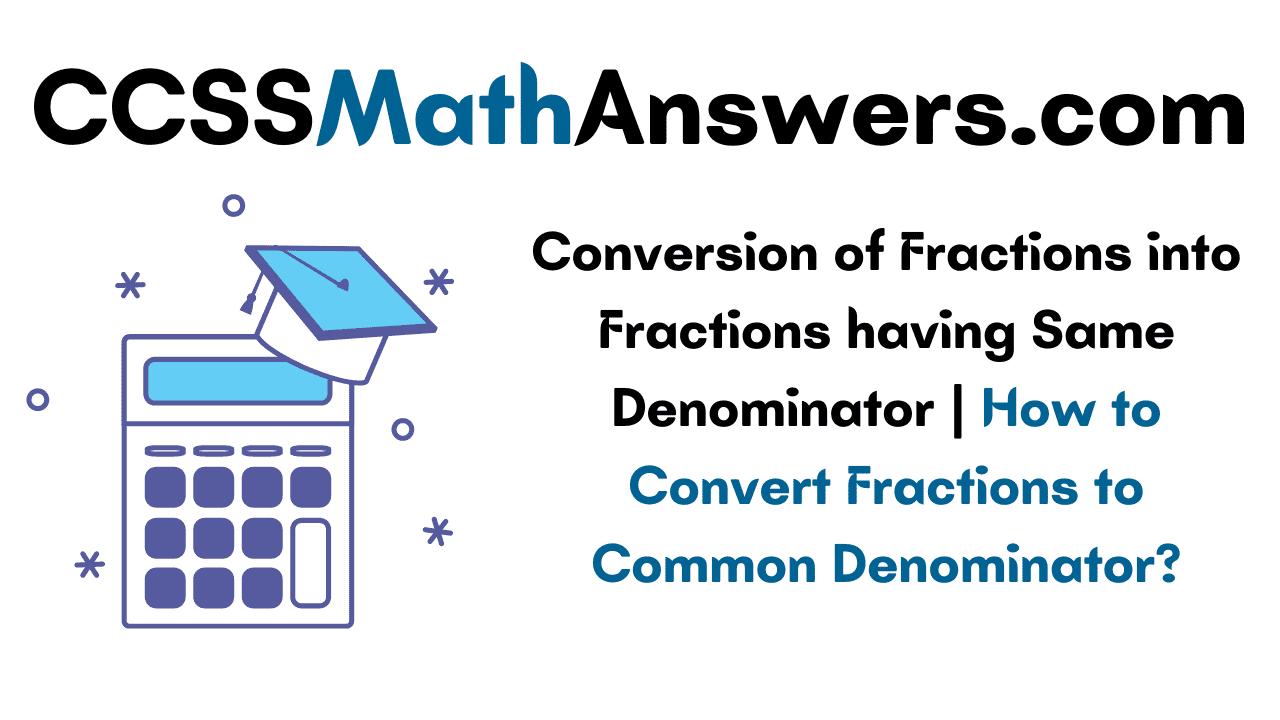Conversion of Fractions to Common Denominator is explained briefly on this page. In order to add or subtract the fractions, the fractions must have a common denominator. The denominator is the bottom number in a fraction. Common Denominator is nothing but the fractions having the same number. The fractions having the same denominator are called Like fractions. Let us discuss the Conversion of Fractions into Fractions having the Same Denominator.
Do Refer:
- Addition of Like Fractions
- Addition of Fractions having the Same Denominator
- Comparison of Fractions having the Same Numerator
How to Change Fractions to Fractions having the Same Denominator?
To change the denominator of a fraction to another number, divide the denominator you want by the denominator you have and then multiply by your numerator to get another number. There are some steps to convert the fraction into a fraction having a like denominator.
1. Check whether the fractions having the same denominators or not.
2. If the denominators are not the same then cross multiply the two fractions and add the results together to get the same denominator.
3. You will get the new numerator with the same denominator.
4. After converting the fraction into a fraction with the same denominator you can perform the arithmetic operations.
Converting Fractions to Fractions with Common Denominators Examples
Example 1.
Convert \(\frac{2}{3}\) and \(\frac{5}{6}\) into fractions having same denominator.
Solution:
The fractions to be converted are \(\frac{2}{3}\) and \(\frac{5}{6}\)
First, check whether the fractions having the same denominators or not.
The given fractions are having different denominators.
The factors of 3 are 1, 3
The factors of 6 are 1, 2, 3, 6
The L.C.M. of 3 and 6 is 6.
\(\frac{2}{3}\) × \(\frac{2}{2}\) = \(\frac{4}{6}\)
Now the converted fractions are having the same denominators.
\(\frac{4}{6}\) and \(\frac{5}{6}\) are having same denominators.
Example 2.
Convert \(\frac{4}{6}\) and \(\frac{7}{12}\) into fractions having same denominator.
Solution:
The fractions to be converted are \(\frac{4}{6}\) and \(\frac{7}{12}\)
First, check whether the fractions having the same denominators or not.
The given fractions are having different denominators.
The factors of 6 are 1, 2, 3, 6
The factors of 12 are 1, 2, 3, 4, 6, 12.
Thus the L.C.M. of 6 and 12 is 12.
\(\frac{4}{6}\) × \(\frac{2}{2}\) = \(\frac{8}{12}\)
Now the converted fractions are having the same denominators.
\(\frac{8}{12}\) and \(\frac{7}{12}\) fractions having same denominator.
Example 3.
Convert \(\frac{8}{12}\) and \(\frac{11}{24}\) into fractions having same denominator.
Solution:
The fractions to be converted are \(\frac{8}{12}\) and \(\frac{11}{24}\)
First, check whether the fractions having the same denominators or not.
The given fractions are having different denominators.
The factors of 12 are 1, 2, 3, 4, 6, 12.
The factors of 24 are 1, 2, 3, 4, 6, 12, and 24.
Thus the L.C.M. of 12 and 24 is 24.
\(\frac{8}{12}\) × \(\frac{2}{2}\) = \(\frac{16}{24}\)
Now the converted fractions are having the same denominators.
Thus \(\frac{16}{24}\) and \(\frac{11}{24}\) fractions having same denominator.
Example 4.
Convert \(\frac{4}{5}\) and \(\frac{7}{10}\) into fractions having same denominator.
Solution:
The fractions to be converted are latex]\frac{4}{5}[/latex] and \(\frac{7}{10}\)
First, check whether the fractions having the same denominators or not.
The given fractions are having different denominators.
The factors of 5 are 1, 5.
The factors of 10 are 1, 2, 5 and 10
Thus the L.C.M. of 5 and 10 is 10.
\(\frac{4}{5}\) × \(\frac{2}{2}\) = \(\frac{8}{10}\)
Now the converted fractions are having the same denominators.
Therefore \(\frac{8}{10}\) and \(\frac{7}{10}\) fractions having like denominator.
Example 5.
Convert \(\frac{23}{40}\) and \(\frac{11}{46}\) into fractions having same denominator.
Solution:
The fractions to be converted are \(\frac{23}{40}\) and \(\frac{11}{46}\)
First, check whether the fractions having the same denominators or not.
The given fractions are having different denominators.
The L.C.M. of 40 and 46 is 920.
\(\frac{23}{40}\) × \(\frac{23}{23}\) = \(\frac{529}{920}\)
\(\frac{11}{46}\) × \(\frac{20}{20}\) = \(\frac{220}{920}\)
Now the converted fractions are having the same denominators.
Therefore, \(\frac{529}{920}\) and \(\frac{220}{920}\) fractions having same denominator.
Example 6.
Convert \(\frac{1}{3}\) and \(\frac{5}{6}\) into fractions having same denominator.
Solution:
The fractions to be converted are \(\frac{1}{3}\) and \(\frac{5}{6}\)
First, check whether the fractions having the same denominators or not.
The given fractions are having different denominators.
The factors of 3 are 1, 3
The factors of 6 are 1, 2, 3, 6
The L.C.M. of 3 and 6 is 6.
\(\frac{1}{3}\) × \(\frac{2}{2}\) = \(\frac{2}{6}\)
Now the converted fractions are having the same denominators.
Thus \(\frac{2}{6}\) and \(\frac{5}{6}\) are having same denominator.
Example 7.
Convert \(\frac{7}{15}\) and \(\frac{9}{30}\) into fractions having same denominator.
Solution:
The fractions to be converted are \(\frac{7}{15}\) and \(\frac{9}{30}\)
First, check whether the fractions having the same denominators or not.
The given fractions are having different denominators.
The L.C.M of 15 and 30 is 30.
\(\frac{7}{15}\) × \(\frac{2}{2}\) = \(\frac{14}{30}\)
Now the converted fractions are having the same denominators.
Therefore \(\frac{14}{30}\) and \(\frac{9}{30}\) are having same denominator.
Example 8.
Convert \(\frac{1}{4}\), \(\frac{3}{4}\) and \(\frac{1}{2}\) into fractions having same denominator.
Solution:
The fractions to be converted are \(\frac{1}{4}\), \(\frac{3}{4}\) and \(\frac{1}{2}\)
First, check whether the fractions having the same denominators or not.
The given fractions are having different denominators.
The L.C.M of 2, 4, 4 is 4.
\(\frac{1}{2}\) × \(\frac{2}{2}\) = \(\frac{2}{4}\)
Now the converted fractions are having the same denominators.
Thus \(\frac{1}{4}\), \(\frac{3}{4}\) and \(\frac{2}{4}\) are having same denominator.
